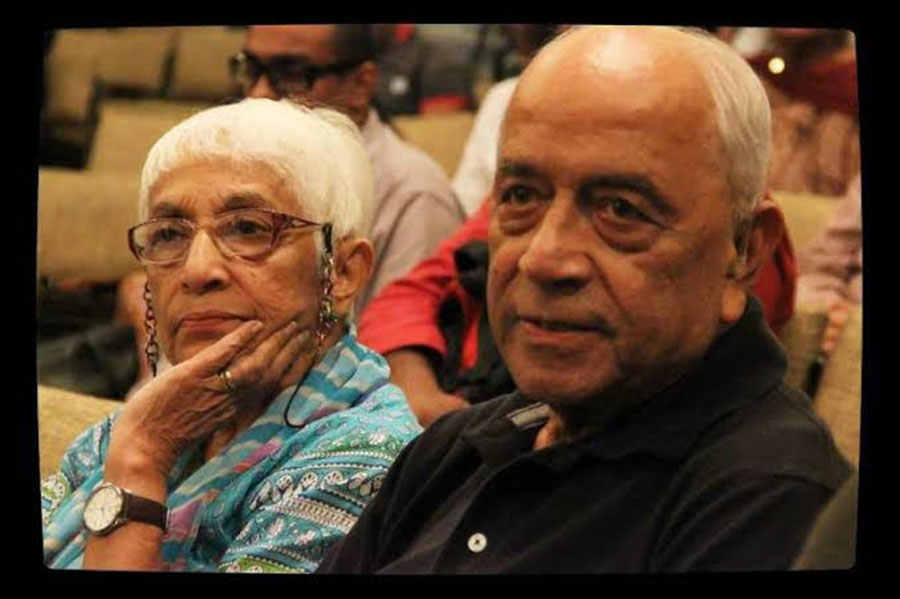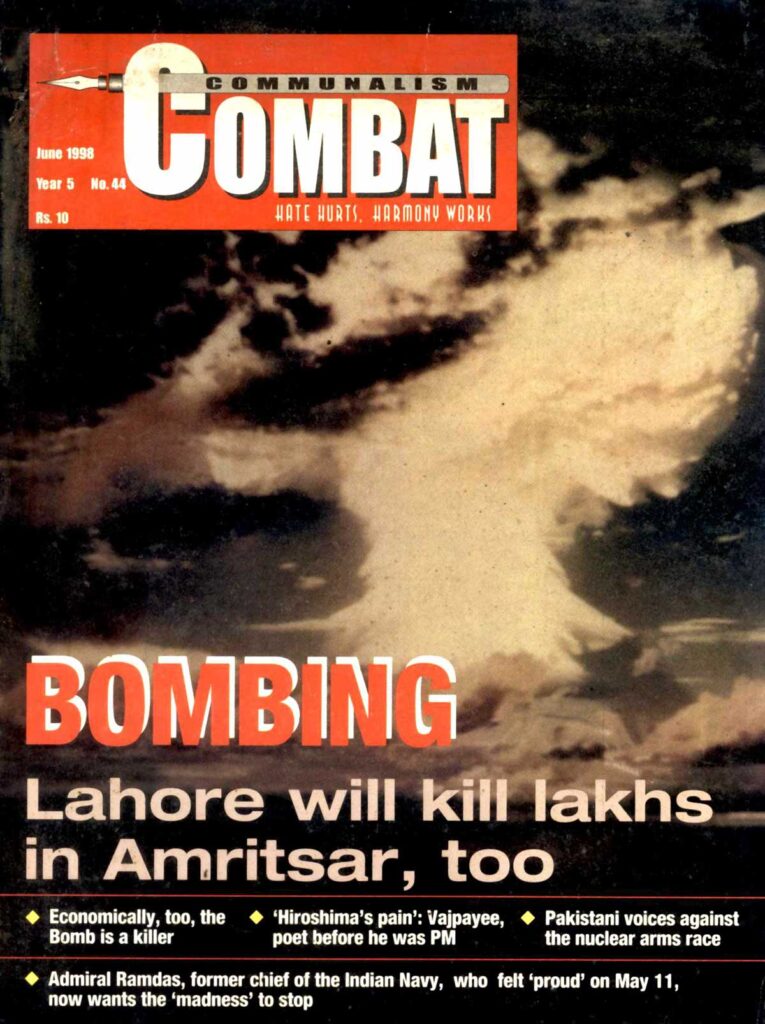On March 15, after a few weeks of illness, Admiral Ramdas, former Chief of the Indian Navy (1990) passed away. He leaves behind wife Lalita Ramdas and his daughters. As editors of Communalism Combat and Sabrangindia.in, as activists and concerned citizens we have had the privilege of knowing Ramu closely and publishing Admiral Ramdas’ writing along with that of Lalita’s (Lolly’s). We re-visit this relationship.
Teesta Setalvad Javed Anand
A personal (and professional) tribute
To converse and be with Lolly (Lalita) and Ramu (former Admiral Ramdas) was to see and behold and admire a couple who have been since we knew them– as Editors, Communalism Combat, as also activists and fellow citizens–always two peas in a pod.
Lalita Ramdas is and was always the light of Ramu’s eye and inspiration
(I still remember how he so candidly write for us in Communalism Combat, (June 1998) about his re-visiting his position as a man of the forces to a determinedly anti-nuke position within days, in June 1998 –shedding years of armed force orientation since age 15.)
Buddha Purnima to Amavasya, we called it and it stands proud in the archives of Communalism Combat. The strapline says it all: Admiral Ramdas, former chief of the Indian Navy, who felt ‘proud’ on May 11, now wants the ‘madness’ to stop
Ramu wrote then about how that re-positioning evolved and came about.
And we also recall and bring to you the piece—ever so honest, jointly written by them that we published as cover story for Communalism Combat (March 1996). They had penned it on Martyr’s Day, January 30, 1996,
“An impassioned piece for communal sanity, respect for the rule of law and social justice,” penned by Admiral Ramdas and Lalita Ramdas, exclusively on Communalism Combat.
The Fire Next Time, we titled it.
There is no better way to pay tribute to Ramu then to speak to Lolly.
And she says today, “We want all our friends to know that we are not mourning Ramu’s demise; we are celebrating his life and spirit. We want all our friends and comrades to celebrate ‘him’ with us; celebrate his indomitable spirit that refused to be cowed down by the mighty and the authoritarians! Ramu will continue to be with us in our peaceful struggles for secularism, peace, rights, justice and human dignity! As passionately as always…”
In losing Ramu we say good bye to the era of civil, rational and fair public servant, who served his people and his country as only he knew how, with head and heart. Even in a less than conscious condition, just a few days back, he turned to Lolly to say, “What is happening with India and Pakistan?”
A question that honestly begs a real answer.
Teesta Setalvad Javed Anand
We reproduce the June 1998 piece here for young readers to re-visit and understand our times
Buddha Purnima to Amavasya
Admiral Ramdas, former chief of the Indian Navy, who felt ‘proud’ on May 11, now wants the ‘madness’ to stop
The news of the Indian nuclear blasts came as a total surprise to many on the evening of May 11. It was also the same in the Ramdas household except with a difference. My wife was totally shocked, depressed and angry, whereas I felt good, proud and, secretly, even happy. My own immediate reactions were triggered by the thought that we have at last decided to tell the arrogant ‘Nuclear Haves’ that enough is enough and we also need to be counted in this world.
The Pakistan-India Peoples Forum for Peace and Democracy (PIPFPD), India Chapter, was keen to issue a statement condemning these tests, but I found myself unable at that time to go along with the draft that finally ensued and released to the press. This was not a very happy situation considering that I was, and still am, the acting-president of the PIPFPD.
This was further worsened by the wanton jingoism displayed by many important leaders in India who ought to have known better. One thing led to the other and events moved inexorably to the inevitable, when on May 28, Chagai Hills in Baluchistan burst into a whitish glow by the tremendous heat and gamma radiation of the Pakistani tests. The leadership on both sides of the border had outdone each other in the display of their madness and in the rape of Nature!
From the night of May 11 until June 3, I underwent a colossal debate within myself. One part of me was feeling elated, yet there was this other part telling me that there is something very wrong here. Almost 45 years of my life, from the age of 15 to 60, were in naval uniform. I had been brought up in the military environment and belonged to the ‘System’ or the ‘Establishment’. Years of training, brainwashing, discipline, learning the art of naval warfare and technology, being an active member and architect of many projects and schemes, all combined to generate the predictable kind of immediate reactions to our tests. It was almost like reflex action which I am sure readers will understand.
Cooler reflection and a critical analysis of the nuclear tests by India and Pakistan and the security and strategic implications became obvious. The great manthan in my mind had finally churned out the answer. This madness which has landed both India and Pakistan in a total mess must stop before things get out of hand. However, the one thing that this ‘madness’ has done is to initiate a wider public debate on nuclear weapons and their relevance to humanity, with particular reference to the sub- continent and its problems. In the wake of the tests, much has been written and spoken in the press and electronic media about the security and other compulsions that forced India to execute Pokhran II (PokhranI 1 was in 1974). It is obvious today that the timing of the tests was more for meeting domestic political requirements and less for security and strategic reasons.
The traditional arguments put forward by the hawks, namely, deterrence, status, power, and our ability to ‘stand tall’, no longer have any credibility and need to be debunked.
The so called proven effectiveness of the deterrence theory in the Cold War has no relevance in the Indo-Pak scenario. In the Cold War, there was never any dispute between the two great super powers, except for propagating their ideological isms and thereby hoping to influence other nations. In the subcontinent, however, there are many outstanding problems that need to be resolved, including the burning issue of Jammu and Kashmir. Clearly, nothing but a political understanding will really resolve these issues and not nuclear bombs and missiles!
I believe large sections of our peoples have not really understood what a nuclear war implies. Most of them still believe it to be an additional new weapon which will kill the enemy and win the war. But there are no winners in a nuclear war. The horrors of a nuclear holocaust are so different that we need to give this wide publicity. Whilst both countries claim to having set up command and control systems, and fool proof methods for initiating a nuclear attack, I would like to sound a note of caution for the information of our peoples in both our countries. Given the best will in the world there are always many things that can go wrong. Human and material failures are not uncommon.
Even in the area of conventional weapons we have been witness to things going wrong. But the price you pay is miniscule when compared to a similar mistake in this ‘Nuclear weaponised sub-continent’. Any and every approaching missile has to be interpreted as one with a nuclear warhead, which is the first step in the nuclear escalation ladder and mutual destruction. One may argue that this horrendous scenario itself guarantees security as this will deter any such action. This argument is difficult to buy as mutual fears and suspicions continue to exist. No one is likely to believe that the other will honour a non-first- use agreement even if we were to sign it. Where does that then lead us?
Given the kind of emotive leadership in both our countries the risks of accidental or deliberate use to preempt the other, cannot therefore be ruled out. To illustrate the point, India’s minister for parliamentary affairs taunted Pakistan to name the place, date and the venue for the next war. Not to be left behind, the foreign minister of Pakistan boasted the other day that they shall win a war with India in 90 minutes. These are the realities that we are up against.
For all these and many other reasons, today I am committed to the campaign for a ban on all nuclear weapons, right across the world. Perhaps this is also the historic moment for India and Pakistan to understand that both our destinies are intrinsically linked through geography and history. Realpolitik and self-preservation demands that the leadership in both India and Pakistan rise above our previous strongly held positions to defuse this highly dangerous situation.
There is absolutely no justification for any of the ‘Nuclear Haves’ to hold nuclear weapons on national security or any other ground. The need of the hour, though, is for both India and Pakistan to cap their entire nuclear and missile programme and to join hands into pressurise the Pancha Pandavas — the Nuclear Haves — to downsize and subsequently totally eliminate all nuclear weapons in a promulgated time frame.
This may sound too far-fetched to many, but do we really have a choice?
Related:
From a former Chief of the Indian Navy, Admiral Ramdas to Rahul Gandhi
The world is watching us: former Admiral L Ramdas to PM Modi and Pres. Kovind
Open Letter to the President of India from former Chief of Indian Navy, Admiral L Ramdas



